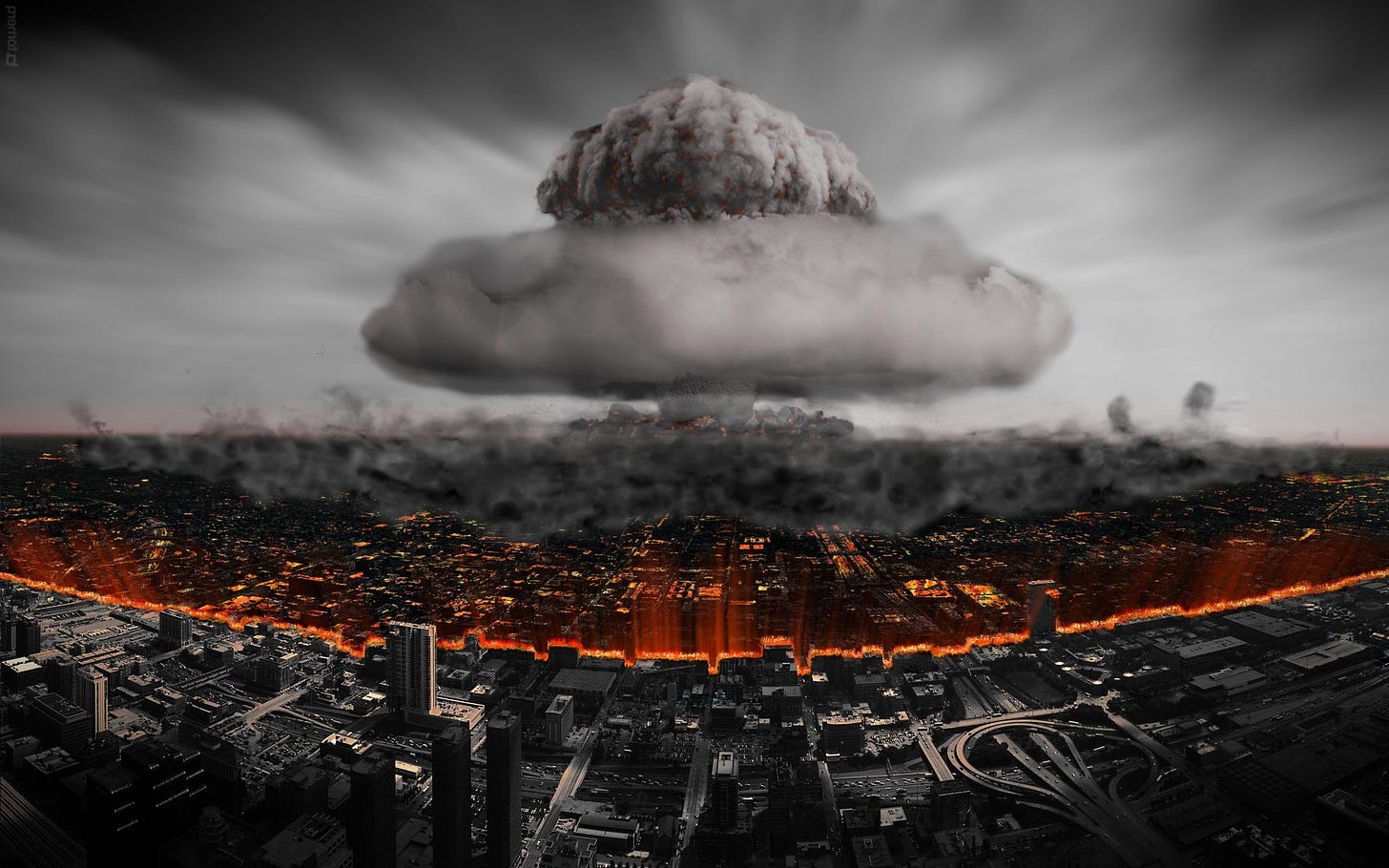(Updated July 2024)
In the shadows of today’s geopolitical tensions, the specter of a looming WWIII evokes echoes of the past. Sixty years ago, during the Cuban Missile Crisis, the world teetered on the brink of nuclear catastrophe.1
As a radio announcer back then, I vividly recall the palpable fear, the relentless monitoring of the AP teletype machine, and the haunting question: Would reason prevail or would chaos consume us?
Today, as we revisit similar uncertainties, the lessons from that pivotal moment in history remain urgently relevant. Or do they? In 1962, Presidents Kennedy and Khrushchev walked us back from the brink. Today, leaders in Washington and European capitals seem to be walking toward it.
It's widely acknowledged, though unofficially confirmed, that Israel commands a substantial nuclear arsenal, with estimates that range up to 200 warheads. This robust nuclear capability underpins Israel’s strategy of deterrence, which signals a readiness to employ these weapons if an existential threats arises — a posture reminiscent of the position adopted by the U.S. Military's Joint Chiefs during the tense days of October 1962. General Curtis LeMay, Chairman of the Joint Chiefs, was ready to pull the trigger.
Referencing my career again, in 1968, I was War News Editor of the American Forces Vietnam Network in Saigon. There was a battle in the Mekong Delta, located south of Saigon, during which a hamlet was destroyed by U.S. Forces during the Tet Offensive. A U.S. officer was quoted by the AP’s Peter Arnett as having exclaimed, “We had to destroy the village in order to save it.”
Invocation of this insane “scorched Earth” strategy during the Tet Offensive sets the stage for our discussion of Israel's Samson Option. This option’s desired intent is also deterrence. The doctrine states that should Israel become face to face with an imminent existential threat, it is prepared, even compelled, to launch nukes. Had the poor villagers of Ben Tre, South Vietnam, possessed that capability, they may well have done the same.
Regardless of how Americans may “feel” about the latest Middle East war, of this fact we may be certain: Israel will not allow itself to be annihilated.
Samson
The name refers to the ancient Biblical figure of Samson, an Israeli judge who pushed apart the pillars of a Philistine temple, bringing down the roof on himself and the thousands of Philistines who had captured him, as recounted in the Book of Judges (Judges 16:30). Theoretically, the ‘Samson Option’ describes Israel "bringing down the temple" upon itself and its enemies, were it deemed to be on the verge of annihilation.
Reiterating, the Samson Option encapsulates Israel's stance on its nuclear deterrence: a commitment to massive retaliation, if necessary, to deter existential threats.
The Samson Option has never been officially confirmed by the Israeli government — Israel has a policy of deliberate ambiguity regarding its nuclear capability. Additionally, Israel neither confirms nor denies it possesses nuclear weapons, although it’s widely understood that it maintains a substantial at-the-ready arsenal.
Some high-profile individuals, such as Martin van Creveld, a professor of military history at the Hebrew University in Jerusalem, have alluded to the Samson Option. He states that the very existence of such a drastic measure acts as a deterrent against attacks on Israel. Perhaps. Iran’s attack on Israel in April 2024 injected nuance into its claim of dominate deterrence.
The Samson Option has been the subject of considerable debate and criticism. While it may well serve as a deterrent, it also is a deeply problematic and risky strategy. This is because of the catastrophic implications of its use — not just for Israel and the Middle East, but potentially for the entire world. The use of nuclear weapons in the Middle East (by any nation) might ignite WWIII.
In 1962, had the Russian ships transporting missiles and other weaponry to Cuba run America’s naval “embargo” (blockade), the outcome could likewise have triggered WWIII.
Seymour Hersh's 1991 book, “The Samson Option,” delves into the history of Israel's nuclear capability, focusing on how the country cultivated its nuclear program as a last-resort in the event of an existential threat. Here is a brief summary.
Key Points
Secrecy and Deception - Hersh outlines how Israel managed to keep its nuclear program under wraps for years, despite being under close international scrutiny.
International Collaboration - The book details Israel's collaborations with countries like France to develop its nuclear program, often in secret, even as it was officially denying the existence of any such program.
The Role of Individuals - Important figures in the Israeli government and military, such as David Ben-Gurion, Shimon Peres and others, are discussed in terms of their roles in making the nuclear program a reality.
Ambiguity as Policy - As I mentioned, Israel has never officially confirmed nor denied its nuclear capabilities, a policy of ambiguity that, according to Hersh, serves its interests by deterring potential aggressors without explicitly breaking international laws or norms.
Deterrent or Offensive - Hersh discusses the ethical and strategic implications of Israel having a nuclear arsenal. Is it purely for deterrence, or could it also potentially be used offensively? The Samson Option raises complex ethical questions.
International Reactions - The book explores how other nations, particularly the United States, have reacted to rumors and evidence of Israel's nuclear capabilities, balancing political and strategic considerations. His thorough exploration travels back to the Lyndon Johnson presidency and the ascendance of the Military Industrial Complex, which continues to grow like a cancerous sore on the face of humanity.
The Existential Question - At the heart of the Samson Option is the existential question for Israel - what lengths is it willing to go to in order to survive in a region where it has so many adversaries? We live in a world increasingly forgetful of the horrors that Jews experienced during WWII.
The geopolitical landscape changes rapidly and thrusts topics that once seemed remote into sudden relevance. While the Samson Option is considered a last-resort scenario, its theoretical and strategic implications, while valuable for assessing broader issues in international relations, must now be factored into today’s volatile Middle East calculus.
Two distinct, yet equally pivotal, analyses vis-à-vis 1962 are required to fully get one’s head around the potential trajectory of recent events.
The first is mundane and geopolitical. The U.S. could not permit nuclear missiles under an enemy’s control 90-miles from Miami — the Monroe Doctrine. The Israeli-Hamas-Hezbollah-Houthis war evokes a second, less common spiritual analysis, which is equally important in my opinion. It appeals to the authority and messianic prophecies contained in the Torah and Christian Bible.
The Gog - Magog War
I wrote in detail about this second analysis in a previous article (linked below). Briefly, the current Middle East war could easily escalate into a regional conflict. The escalation could then quickly devolve into the prophesied Gog-Magog War. If so, we could reasonably anticipate the Samson Option being used as Israel would then be faced with multiple existential threats simultaneously.
There’s a new twist. Some experts believe Israel also possesses neutron bombs and is prepared to use them. Clearly, the IDF is presently incapable of launching a ground invasion of Lebanon.
A neutron bomb, also known as an enhanced radiation weapon (ERW), is a type of low-yield (tactical) thermonuclear weapon. We don’t know if ERWs fall under the aegis of the Samson Doctrine or not. Its design aims to maximize lethal neutron radiation in the immediate vicinity of the blast while minimizing the physical power of the blast itself.
Unlike traditional nuclear weapons, which primarily cause blast and heat damage, a neutron bomb intentionally allows the neutron release generated by nuclear fusion to escape the weapon. This neutron burst is more effective at penetrating enemy armor, making it more lethal as a tactical weapon with anti-personnel attributes.
The concept was originally developed by the United States in the late 1950s and early 1960s. ERWs were first deployed for anti-ballistic missile systems, where the burst of neutrons would prevent nearby warheads from exploding properly.
Analyst Scott Ritter, a former U.S. Marine weapons inspector, noted that Israel may well lead with such weaponry should it attack Lebanon preemptively. Several reliable sources, including former UK diplomat Alastair Crooke, have confirmed over the last few days that the Deep State Cabal has given Israel the ‘green light.’ (This exposes troubling aspects of the recent U.S. coup.)
We also know from reliable Biblical sources that God intends to assert his will in the Gog-Magog conflict.
Then I will knock the bow out of your left hand, and cause the arrows to fall out of your right hand. You shall fall upon the mountains of Israel, you and all your troops and the peoples who are with you; I will give you to birds of prey of every sort and to the beasts of the field to be devoured. You shall fall on the open field; for I have spoken, says the Lord God.
Ezekiel 39:3-5
(Also updated July 2024:)
Gog, Magog and the Armies of Satan
I have made you a watchman for the house of Israel; therefore you shall hear a word from my mouth and warn them for me. ~ Ezekiel 33:7 The biblical narrative of Gog and Magog, which is found in Genesis, 1 Chronicles and Ezekiel in the Old Testament and the book of Revelation in the New Testament, has been interpreted in various ways, often to fit the exig…
I encourage anyone unfamiliar with the 1962 Cuban Missile Crisis to watch Thirteen Days, an excellent documovie (2020) starring Kevin Costner.







Samson has no relationship whatsoever with the jew they are all European. Folks should research historical facts. Before colonization all these countries were black until the ottomans started colonization.